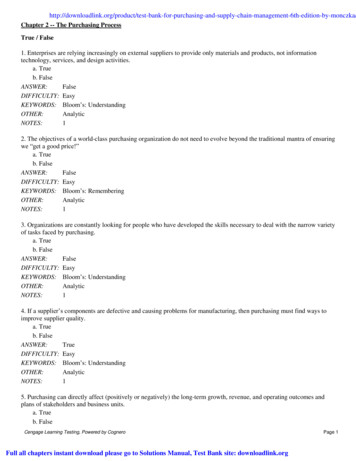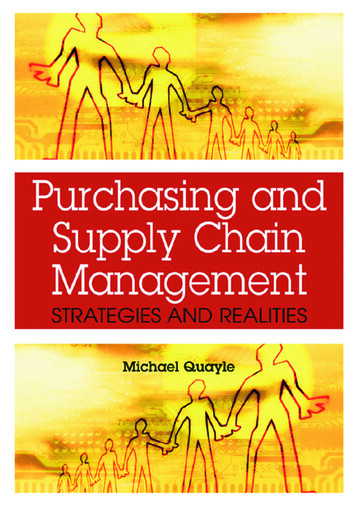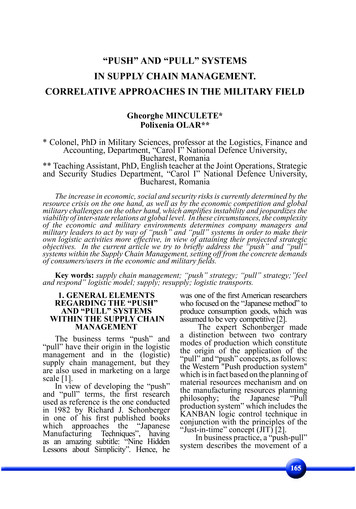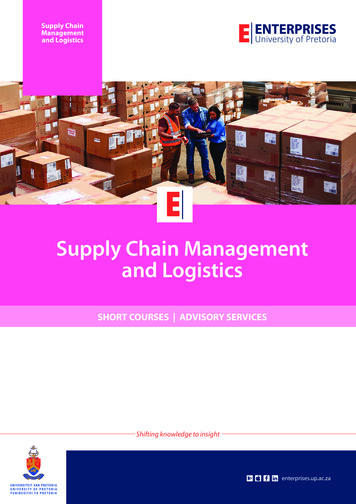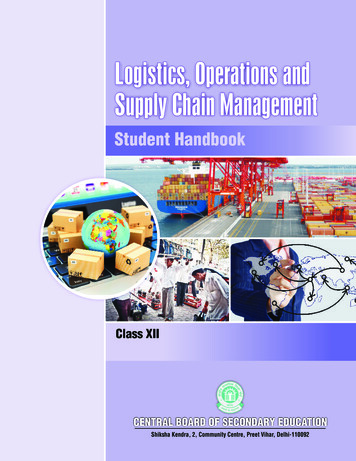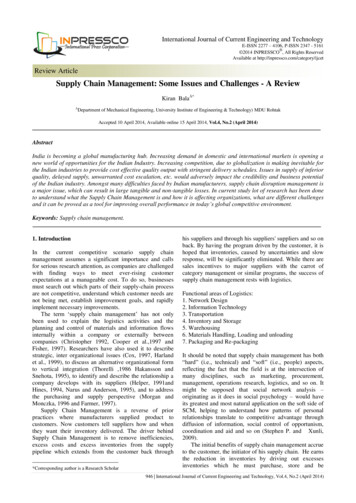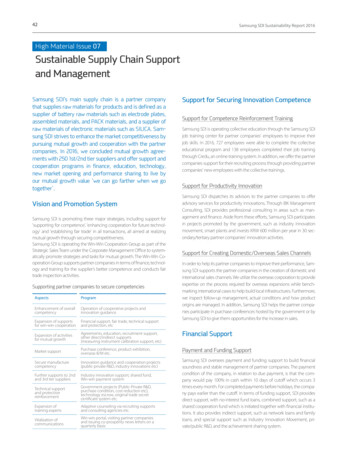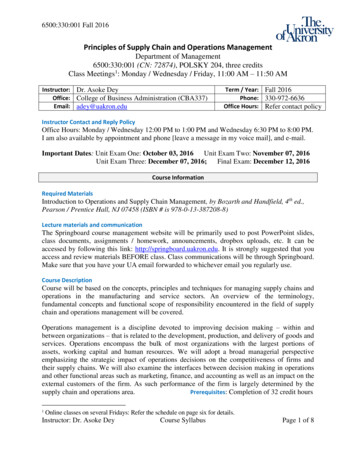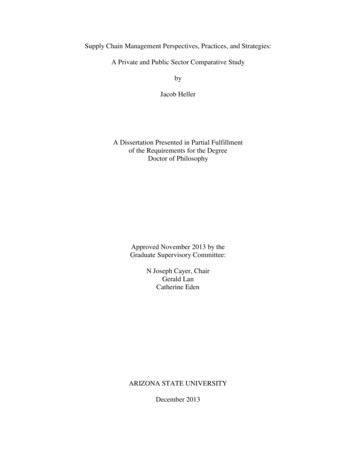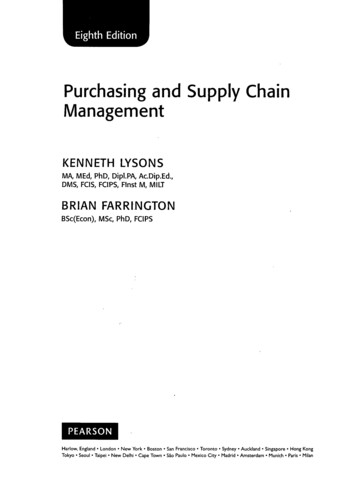
Transcription
Eighth EditionPurchasing and Supply ChainManagementKENNETH LYSONSMA, MEd, PhD, Dipl.PA, AcDip.Ed.,DMS, FCIS, FCIPS, Flnst M, MILTBRIAN FARRINGTONBSc(Econ), MSc, PhD, FCIPSPEARSONHarlow, England London New York Boston San Francisco Toronto Sydney Auckland Singapore Hong KongTokyo Seoul Taipei New Delhi Cape Town Sao Paulo Mexico City Madrid Amsterdam Munich Paris Milan
ContentsPrefaceAcknowledgementsPublisher's acknowledgementsPlan of the bookxvixviixviiixixPart 1 Introduction and strategyi1 What is purchasing?3Learning outcomesKey ideasIntroduction1.1 Perspectives on purchasing1.2 Definitions1.3 The evolution of purchasing1.4 Purchasing and change1.5 World class purchasing1.6 The status of purchasing and supply management (PSM)Case studyDiscussion questionsPast examination questionsReferences33345916171926272728230Strategy and strategic procurementLearning outcomesKey ideasIntroduction2.1Strategic thinking2.2What is strategy?2.3Strategy development2.4Levels of organisational strategy2.5Corporate strategy2.6Growth strategies2.7Business-level strategy2.8Strategic management2.9Strategic analysis2.10 Important environmental factors2.11 Internal scrutiny2.12 Strategy formulation2.13 The evaluation of alternative strategies2.14 Strategy implementation2.15 Post-implementation evaluation, control and review2.16 Strategic purchasing and supply chain process models30303131323437383841444445495156677173vii
ContentsCase studyDiscussion questionsPast examination questionsReferences76777879381Logistics and supply chainsLearning outcomesKey ideasIntroduction3.1What is logistics?3.2Materials, logistics and distribution management3.3Reverse logistics3.4Supply chains3.5Supply chain management (SCM)3.6Supply chain vulnerability3.7SCM and logistics3.8Value chains3.9Value chain analysis3.10 Supply chain optimisation3.11 Supply chains and purchasingCase studyDiscussion questionsPast examination 1121131141144117Structure and supply chainsLearning outcomesKey ideasIntroduction4.1Organisational structures4.2New type organisations4.3Networks4.4Factors in configurations4.5Lean organisations4.6Agile organisations and production4.7Supply and value chain mappingCase studyDiscussion questionsPast examination 481491501505153Purchasing structure and designLearning outcomesKey ideasIntroduction5.1Business environmental factors and purchasing structures5.2Purchasing as a functional departmentVIM153153154154156
Contents5.3Horizontal organisations and processes5.4Teams5.5Cross-functional purchasing5.6Some problems of cross-functional teams5.7Cross-organisational teams5.8Divisional purchasing structures5.9Centralised purchasing5.10 Decentralised purchasing5.11 Purchasing in multi-plant organisations5.12 Evolving purchasing structures5.13 Organisational changeCase studyDiscussion questionsPast examination 701741751761766178Purchasing procedures and supporting toolsLearning outcomesKey ideasIntroduction6.1The sequence and impact of purchasing procedures6.2Analysing a procurement process6.3E-commerce, e-business, e-SCM and e-procurement6.4The evolution of e-procurement models6.5Electronic data interchange (EDI)6.6E-hubs, exchanges, portals and marketplaces6.7E-catalogues6.8E-auctions6.9Reverse auctions6.10 E-payment6.11 Low-value purchases6.12 Purchasing manuals6.13 Supplier manuals6.14 Legal aspects of purchasingCase studyDiscussion questionsPast examination 95196200202203205206210211212212Part 2215Strategy, tactics and operations 1: purchasing factors7 Supplier relationships217Learning outcomesKey ideasIntroduction7.1Relationship purchasing and purchasing relationships7.2The contrast between transactional and relationship purchasing,taking account of contractual requirements217217217218218ix
Contents7.3Collaborative business relationships7.4Relationship formation7.5Models of supplier relationships7.6Practical considerations of supplier relationship management7.7The termination of relationships7.8Further aspects of relationshipsCase studyDiscussion questionsPast examination 238Purchasing: product innovation, supplier involvement and developmentLearning outcomesKey ideas8.1Innovation and kaizen8.2 Environmentally sensitive design8.3Purchasing and new product development8.4 Early supplier involvement (ESI)8.5 Advantages and problems of ESI8.6 Supplier development8.7 Supplier associations'(SA)Case studyDiscussion questionsPast examination 572582589Specifying and managing product quality260Learning outcomesKey ideas9.1 What is quality?9.2 Quality systems9.3 The importance of TQM9.4 Specifications9.5 Alternatives to individual specifications9.6 Standardisation9.7 Variety reduction9.8 Quality assurance and quality control9.9 Tests for quality control and reliability9.10 The cost of quality9.11 Value management, engineering and analysisCase studyDiscussion questionsPast examination 8029329330530530730810309Matching supply with demandLearning outcomesKey ideas10.1Inventory, logistics and supply chain management309309309
Contents10.2Reasons for keeping inventory10.3Inventory classifications10.4 Scope and aims of inventory management10.5Some tools of inventory management10.6 The economics of inventory10.7Inventory performance measures10.8Safety stocks and service levels10.9 The right quantity10.10 The nature of demand10.11 Forecasting demand10.12 'Push' and 'pull' inventories10.13 Independent demand10.14 Dependent demand10.15 Just-in-time (JIT)10.16 Materials and requirements planning (MRP)10.17 Manufacturing resource planning (MRP II)10.18 Enterprise resource planning (ERP)10.19 Supply chain management systems10.20 Distribution requirements planning (DRP)10.21 Vendor-managed inventory (VMI)10.22 Purchasing and inventoryCase studyDiscussion questionsPast examination 32933033433434134534734934935135435435535635711 Sourcing and the management of suppliers358Learning outcomesKey ideas11.1 What is sourcing?11.2 The sourcing process11.3Sourcing information11.4 Analysis of market conditions11.5Directives11.6 E-sourcing11.7 Locating suppliers11.8 Supplier assessment11.9 Supplier approval11.10 Evaluating supplier performance11.11 Policy issues in sourcing11.12 The supplier base11.13 Outsourcing11.14 Outsourcing manufacturing11.15 Outsourcing services11.16 Drivers of outsourcing11.17 Types of outsourcing11.18 Benefits of outsourcing11.19 Problems of 379380381386388388388389xi
ContentsXII11.20 Handling an outsourcing project11.21 Sub-contracting11.22 Partnering11.23 Intellectual property rights and secrecy.24 Support for marketing.25 Intra-company trading11.26 Local suppliers.27 Purchasing consortia.28 Sustainability.29 Sourcing decisions.30 Factors in deciding where to buyCase studyDiscussion questionsPast examination 1041241341441512 Managing purchase prices417Learning outcomesKey ideas12.1 What is price?,12.2 The buyer's role in managing purchase prices12.3 Supplier pricing decisions12.4 The supplier's choice of pricing strategy12.5Price and cost analysis12.6 Competition legislation12.7 Collusive tendering12.8Price variation formulaeCase studyDiscussion questionsPast examination 38440441442Part 3 Strategy, tactics and operations 2: buying situations44313 Contrasting approaches to supply445Learning outcomesKey ideasIntroduction13.1Industrial products13.2 Capital investment items13.3Capital expenditure13.4 Factors to be considered when buying capital equipment13.5 Controlling the acquisition of capital equipment13.6 New or used equipment13.7 Financing the acquisition of capital equipment13.8 Selecting suppliers of capital equipment13.9 Evaluating capital investments13.10 The buyer and capital investment purchases445445446446446447448449450452456458461
Contents13.11 Production materials13.12 Raw materials13.13 Futures dealing13.14 Methods of commodity dealing13.15 Purchasing non-domestic gas and electricity13.16 Energy regulation13.17 Energy supply chains in the UK13.18 Markets13.19 Pricing13.20 Procuring energy contracts13.21 Energy consultants and management13.22 Component parts and assemblies13.23 Consumables13.24 Construction supplies and bills of quantities13.25 Purchasing servicesCase studyDiscussion questionsPast examination questionsReferences14Buying from overseasLearning outcomesKey ideas14.1Terminology14.2Motives for buying from overseas14.3Sources of information for overseas suppliers14.4Overcoming challenges when sourcing overseas14.5Incoterms14.6Ocean shipping terminology14.7Customs and excise14.8Transport systems, costs and considerations14.9Freight agents14.10 Methods of payment14.11 Countertrade14.12 The true cost of overseas buying14.13 Buying capital equipment overseas14.14 Factors in successful overseas buyingCase studyDiscussion questionsPast examination questionsReferencesPart 415Strategy, tactics and operations 3: negotiation, supporttools and performanceNegotiationLearning outcomesKey ideas462462464467470470470471' 25525525xiii
ContentsXIVIntroduction15.1Approaches to negotiation15.2 The content of negotiation15.3Factors in negotiation15.4 The negotiation process15.5Pre-negotiation15.6 The actual negotiation15.7Post negotiation15.8What is effective negotiation?15.9Negotiation and relationships15.10 Negotiation ethicsCase studyDiscussion questionsPast examination 5255655755855916 Support tools560Learning outcomesKey ideas16.1Tendering16.2Debriefing unsuccessful tenderers16.3Post-tender negotiation (PTN)16.4Application of costing techniques16.5Lifecycle costing16.6 Target costing16.7Absorption costing16.8Activity-based costing (ABC) and management16.9Standard costing16.10 Budgets and budgetary control16.11 Learning curves16.12 Project management16.13 Scheduling16.14 Operational research (OR)Case studyDiscussion questionsPast examination 8258458458959159960260260460517 Purchasing research, performance and ethics606Learning outcomesKey ideas17.1Purchasing research17.2Purchasing performance evaluation17.3Accounting approaches17.4The purchasing management audit approach17.5Benchmarking and ratios17.6Integrated benchmarking17.7Management by objectives (MBO)606606606611613616621628631
Contents17.8Miscellaneous approaches applicable to measuring purchasingperformance17.9Purchasing ethics17.10 Some ethical issues relating to suppliers17.11 Ethical codes and training17.12 Ethical decisions17.13 Purchasing and fraud17.14 Environmental aspects of purchasingCase studyDiscussion questionsPast examination 59Appendix I: Code of professional ethics - Chartered Institute ofPurchasing and Supply (CIPS) (Approved by the CIPS Council,11 March 2009)Appendix 2: Principles and standards of ethical supply managementconduct (ISM) (Adopted May 2008)664Definitions, acronyms and foreign words and phrasesIndex of names and organisationsSubject index665670675662Supporting resourcesVisit www.pearsoned.co.uk/farrington to find valuable online resourcesFor Instructors: Comprehensive Instructor's Manual containing teaching tips and notes on casestudies for each chapter Downloadable PowerPoint slides containing figures from the bookFor more information please contact your local Pearson Education salesrepresentative or visit www.pearsoned.co.uk/farringtonxv
Purchasing and Supply Chain Management KENNETH LYSONS MA, MEd, PhD, Dipl.PA, AcDip.Ed., DMS, FCIS, FCIPS, Flnst M, MILT BRIAN FARRINGTON BSc(Econ), MSc, PhD, FCIPS PEARSON Harlow, England London New York Boston San Francisco Toronto Sydney Auckland Singapore Hong Kong Tokyo Seoul Taipei New Delhi Cape Town Sao Paulo
